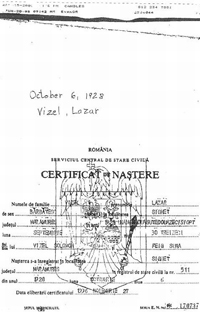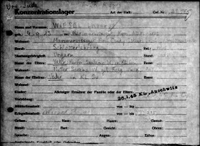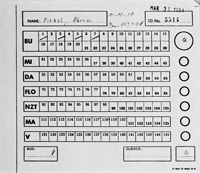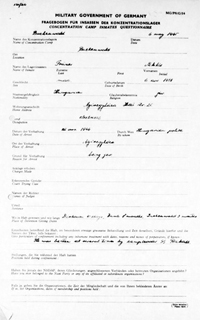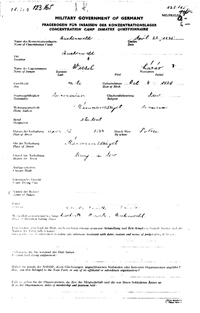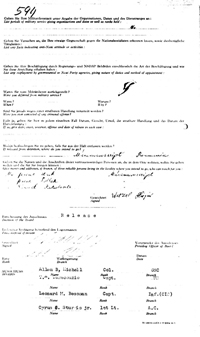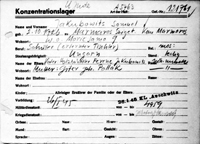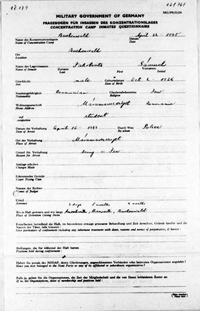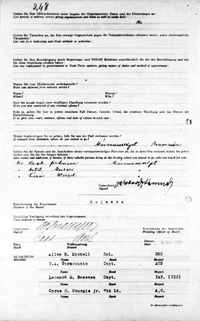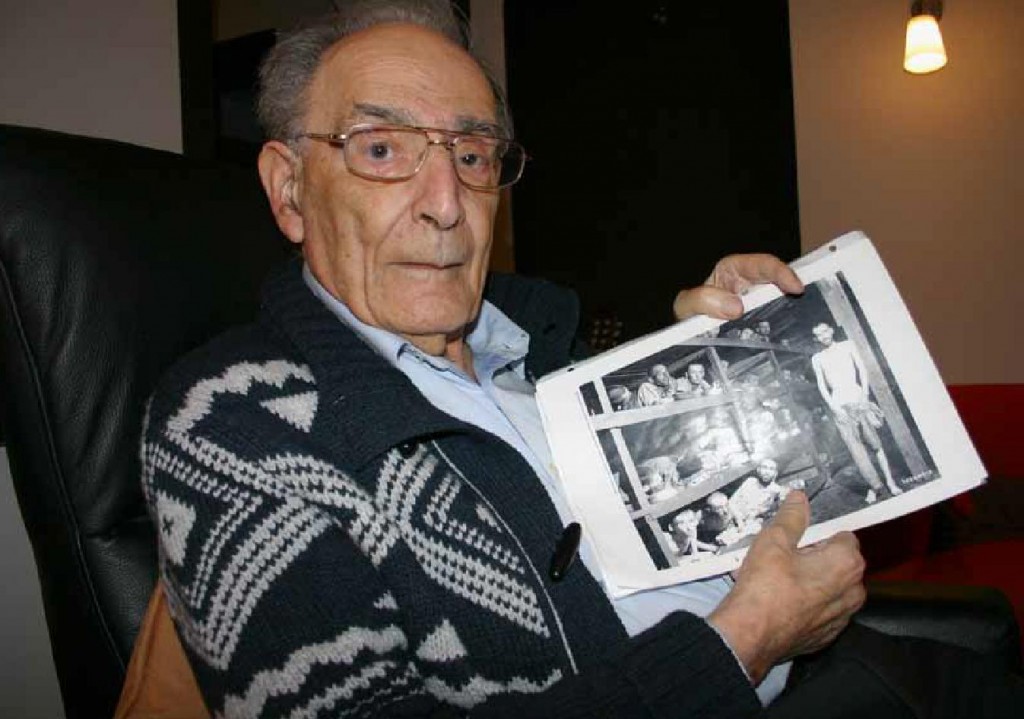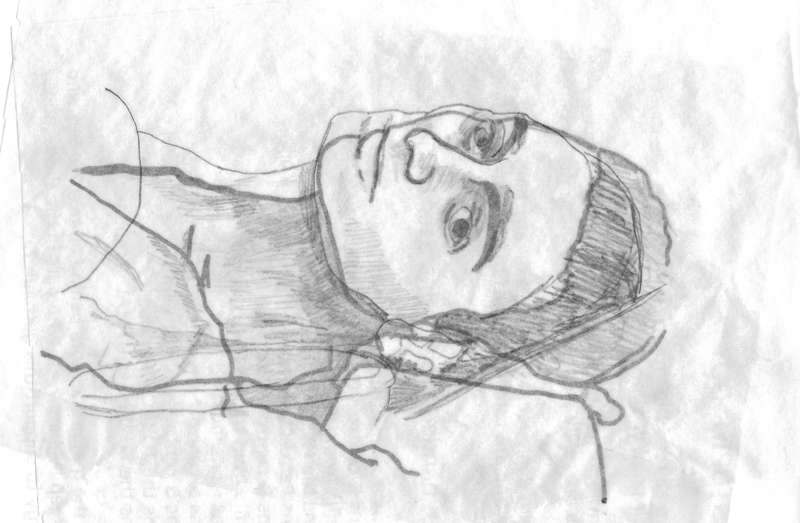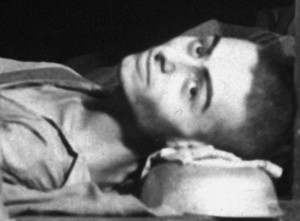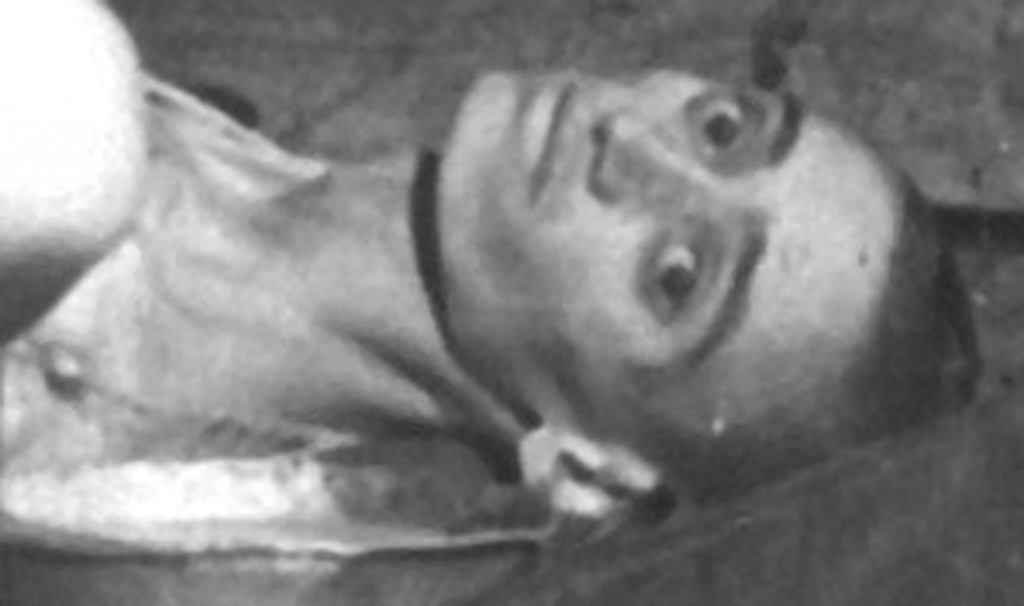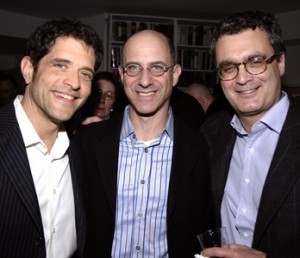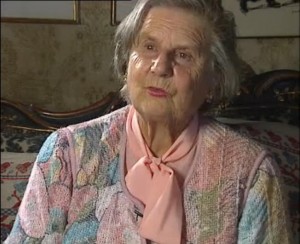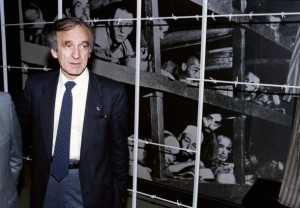The Documents
The Documents
1) Birth certificate for Lazar Vizel issued by the Romanian authorities on November 27, 1996 [see bottom line], in all likelihood at the behest of Wiesel and according to self-identified information. Such a course of action would not be unexpected given the super-celebrity-status of the subject, the Romanian authorities’ willingness to look the other way, and a claim of loss. It is not certain that this is a genuine replica of any original document. The date of October 6, 1928, handwritten at the top of the document and typed in the lower part, represents the date the document was originally issued, not the date of birth.
Wiesel claims in his writings that he was named for his paternal grandfather Eliezer. Eliezer is also the name of the founder of Hasidism, the Wiesel’s particular Orthodox branch of Judaism — Rabbi Yisroel ben Eliezer was the son of Eliezer and Sara! Wiesel also has a cousin named Eliezer Shlomovitz, and probably there are more Eliezers in his family. We don’t see anyone using the name Lazar. While derived from Eliezer, to some this is a different name in practice. So why would Elie Wiesel give his name as Lazar on a new “copy” of his birth certificate … or, if it is indeed a copy of the original, why would his parents give his birth name as Lazar?
The author of Un di velt hot geshvign (And the world remained silent) is also named Eliezer Wiesel. This makes it even more curious as to why his birth certificate is made out for Lazar and not Eliezer.
Wiesel pronounces his name as Vee-zel, so it’s logical that it was entered that way—the same way he spelled his father’s name for the Yad Vashem Central Database of Shoah Victims in October 2004. Salomon is the formal name for Shlomo, and Sura is Romanian-ized Sara. By this certificate, Wiesel at least helpfully confirms his acknowledgement of his birth date as Sept. 30, 1928.
2) A letter dated 8 December 2000, addressed to M. Gruner by the Buchenwald Gedenkstätte (memorial), signed Sabine Stein (fig. 11), contains this information:
Lazar Wiesel, born 4 October 1928, is on a transport list of 16 July 1945 to Paris. The other document is a transport of 26 January 1945 from Auschwitz to Buchenwald, with Viezel, Abraham, born 10 October 1900, Auschwitz Nr. A 7712 and Buchenwald Nr. 123488.
3) A letter dated 15 May 2002, addressed to M. Grüner by the Buchenwald Gedenkstätte (memorial), signed Sabine Stein (fig. 11.1), contains the following information:
Lazar Wiesel, born on 4 September 1913 at Maromarossziget (Sighet), arrived at Buchenwald with a transport from Auschwitz (Buchenwald archives, microfilm Auschwitz, p. 41). On this page 41, under entry number 2438, you will find the data on Lazar Wiesel: Buchenwald number 123565, born on 4 September 1913, Auschwitz number A-7713. These data are confirmed by the numerical file card at the camp office [Schreibstube].(see #5 below)
4) Transport lists, arranged alphabetically, confirming a Jan. 26, 1945 arrival at Buchenwald from Auschwitz, with the names of Lazar Wiesel and Abram Viezel, nos. A-7713 and A-7712 respectively. No other Lazar or Eliezer Wiesel appears. (Fig.11.2, 11.3, 11.5)
5) The numerical file card from Buchenwald mentioned above. In its upper left hand corner the handwritten entry “Ung. Jude” (Hungarian Jew); in the center “Ausch. A 7713” (the former Auschwitz ID number); on the right, “Gef.-Nr.:123565”, (Detainee number 123565, the new Buchenwald ID number).
This detainee was born on 4 September 1913 at Maromarossziget and was the son of Szalamo Wiesel, who was at Buchenwald, and of Serena Wiesel née Feig, interned at KL Auschwitz . The stamp “26.1.45 KL. Auschwitz” indicates that Lazar Wiesel was registered at Buchenwald on 26 January 1945 coming from Auschwitz.
6) A detainee registration card, probably stemming from the Buchenwald memorial archives, has the following data: (Fig. 12.2)
“123565
Wiesel Lazar Polit.
Geb. 4.9.13 Maromarossiget Ungar
Schlosserlehrling Jude
26. Januar 1945”
7) A Buchenwald “Record of changes” on the subject of Abraham Viezel (Fig.11.4). It says that Abraham Viezel died on 2 February 1945 in Block 57, according to the camp record of February 3rd. He was born 10 October 1900, a Jewish political detainee, with the ID numbers A-7712 for Auschwitz and 123448 for Buchenwald.
“Datenbank: Veränderungsmeldungen Buchenwald
Datensatz: 9315
Häftlingsnr.: 123488 [A 7712]
Name: Viezel, Abraham
geboren: 10.10.00
Nationalität:
Kategorie: polit. Jude
Einlieferung:
gestorben: 02.02.45
in: Block 57
Meldung vom: 03.02.45”
8) Death Certificate for Abram Viezel. Date of birth and ID number 123488 correspond. “5514” is the registration number for his death.
9) A letter from the Auschwitz Museum to Miklós Grüner dated 7 July 2003 (Fig. 18.1, 18.2) which states that detainees ID A-7713 and A-7712 appear in a list (Fig. 19, 19.1, 19.2) of the SS Hygiene Institute dated 7 December 1944-Monowitz and giving the following data:
A-11104 Grüner Miklos, Hungarian Jew, born on 6 April 28 at Nyiregyhaza
A-7712 Viesel Abram, born on 10 October 1900 at Marmarosz
A-7713 Wiesel Lazar, born on 4 September 1913 in Marmarossziget, Schlosser (locksmith)
10) “Concentration Camp Inmates Questionnaire” (front only) of the Military Government of Germany, at Buchenwald in May of 1945, for Miklos Grüner, another proof that he was ‘liberated’ from there.
Lázár Wiesel, b. Oct. 4, 1928, enters the picture …
11) “Concentration Camp Inmates Questionnaire” (front and back) of the Military Government of Germany, at Buchenwald in April of 1945, for a Lázár Wiesel (note accented spelling), a Romanian Jew born Oct. 4, 1928, ID number 123165. He was arrested on April 16, 1944. Here, however, there is a disagreement with respect to the numerical file card. The Schreibstube file card numbered 123165 was made out for a Slovakian Jewish detainee, Pavel Kun (Fig.12.1), who died at Buchenwald on 8 March 1945, one month prior to this number showing up as belonging to Lázár Wiesel. This file card has the nr.123165 crossed out. Pavel Kun is also on a transport list (Fig. 12.3) from Auschwitz to Buchenwald, 26 January 1945, in the section headed Slowaken Juden, born on 6 July 1926 at Velka Bytca, registered at Auschwitz as B-14131.
On this Buchenwald questionnaire, answering the question “Give names and addresses, if known, of three reliable persons living in the locality where you intend to go who can vouch for you,” Lázár Wiesel wrote: “Ur [Mr.] Ferenc Stark, Ferenc Pollak, Sámuel Jakobovits”. This latter person was also at Buchenwald; he had arrived there from Auschwitz in the convoy of 26 January 1945.
12) Buchenwald file card of Samuel Jakobovits indicates that, at Auschwitz, his number had been A-5763, and his Buchenwald registration number was 121761; he was born on 2 October 1926 at Marmarossziget, his mother’s maiden name was Pollak, who was probably related to the inmate Ferenc Pollak mentioned by Lázár Wiesel. (During Wiesel’s and Grüner’s meeting in Sweden, arranged by the Sydsvenska Dagbladet, after the Nobel Prize had been given to Elie Wiesel, they both told reporters they didn’t know each other and had never met in the camp.1)
13) “Concentration Camp Inmates Questionaire” for Sámuel Jakobovits of the Military Government of Germany, at Buchenwald, dated 22 April 1945 (front & back).
The references given by Jacobovits are: Hersch Fischmann, Antal Meisner and, specifically, Lázár Wiesel. The front page also gives the date of Sámuel’s arrest – 16 April 1944, the same date as Lázár Wiesel’s. At Auschwitz, Sámuel received number A-5763, assigned on 26 May 1944: on that day, 2,000 Hungarian Jews were registered under the file numbers A-5729 through 7728. Hence, both Abram Wiesel (A-7712) and Lazar Wiesel (A-7713), born on 4 September 1913, were part of this transport. But how did Lázár Wiesel, born on 4 October 1928, get there, who has no Buchenwald file card, no Auschwitz number and a dead man’s Buchenwald registration number?
14) One page from 11 pages listing children sent from Germany to France, July 16, 1945, that shows Lazar Wiesel, b. Oct 4, 1928 in Marmorossziget, as number 405. (Fig. 12.4, 12.5)
From the above, the first question we must ask is: Are we are dealing with two different persons in Lazar Wiesel and Lázár Wiesel, or the same person? If the same, why the different birth dates, and name spelling? The Lázár born on 4 October 1928 does not have any previous history at Auschwitz or Buchenwald. The Lazar with the history, born 4 September 1913, does not have a “liberation” questionaire. The “new” Lázár is listed on the transport to France in July 1945.
These are the questions and quandries we are working with.
Endnote:
1) “After Auschwitz — Birkenau, Buna, Nikolaj, Gleiwitz and Buchenwald awaited both Elie and Michael. To Buchenwald they arrived in February 1945. (It was a January 26 transport. Did Elie say February?-cy) They found themselves in Block 51. (Childrens’ Block was 66-cy) Do they remember each other? – No, both of them reply.”
“Lägerfångar möts efter 42 år” (Camp inmates meet after 42 years), Sydsvenska Dagbladet, 15 December 1986, p. 6.
Max Hamburger Says He Is the ‘Zombie Man’ in the Lower Bunk
By Carolyn Yeager
Max Hamburger, a Jewish-Dutch psychiatrist, is the man in the above photograph taken in 2012. He is 92 years of age.
Hamburger has identified himself as the fourth figure in the bottom row of the famous Buchenwald photo — the figure he is pointing to with his thumb. He was 25 years-old in April 1945 when the camp was “liberated” by American troops. I want you to notice right away the space between Hamburger’s nose and upper lip — it is unusually long. The face of the young man in the famous photo does not have that long space, but just a normal, or even short, distance between nose and mouth. This is facial structure that doesn’t change, which is one clue that tells me he is not the same person.
Born on February 10, 1920 in Amsterdam, Max began the study of medicine in 1938 and, as best I can make out from Dutch language sources, he was arrested in 1942 because of his activism in the Dutch Resistance and sent to Westerbork, a camp for political prisoners in The Netherlands. He ended up in Auschwitz and then Buchenwald, he says, taking the usual route. According to this page, he was suffering from TB, and also malnutrition, when the famous photo he’s holding in his hands was taken.
The blurb on the Flicker page also says “he only survived Auschwitz because he could work as a medical assistant.” One has to ask about all those who didn’t work as a medical assistant, but also survived and went to Buchenwald … and survived Buchenwald too without being medical assistants! This is the kind of meaningless tripe we are always given to explain why people survived “death camps.” This page also says he now (in 2008) lives in Belgium and gives talks about his wartime experiences. In other words, he advertises himself as a holocaust survivor who is in the Famous Buchenwald Liberation Photo, the one that Elie Wiesel is in. (See final section below)
It should be noted that Nicholas Grüner is in this photo too; he is the first person on the left in the bottom row and the only one of the three mentioned who actually looks like himself, and is himself. Yet the labeling of this photograph at Yad Vashem Holocaust Memorial in Jerusalem (below) gives three possible identities for this figure: Gershon Blonder, Josef Reich or Nicholas (Miklos) Grüner … as if it were in doubt. The other two are not shown to be in doubt: the fourth figure on the bottom is Max Hamburger; the seventh figure in the 2nd row is Elie Wiesel. It’s clear to me that Yad Vashem will eventually deny that Nicholas Grüner is in the photo at all, and thus his claim that Elie Wiesel was not in the camp (or the photo) will be weakened. These people are nothing if not devious … and they accomplish their objective in a gradual manner. According to Yad Vashem …
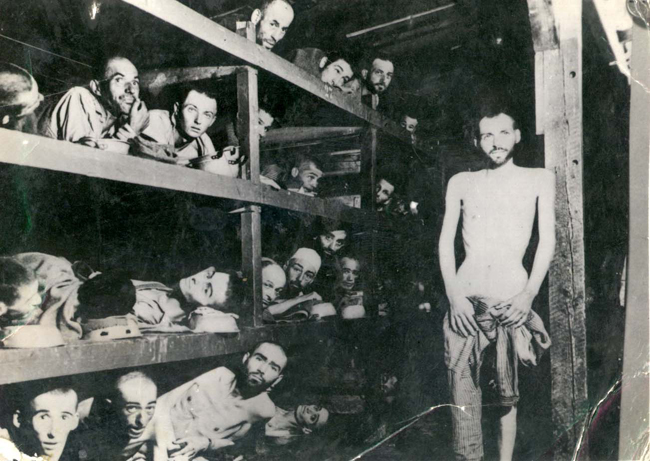 Second bunk:
Second bunk:
First from right– Elie Wiesel
Fourth from right:
• Herman Leefsma or
• Abraham Hipler or
• Berek Rosencajg or
• Zoltan Gergely
Fifth from right:
• Lajos Vartenberg (Yehuda Doron) or
• Yaakov Marton
Bottom bunk:
First from right – Max Hamburger
Third from right – Issac Reich
Fourth from right:
• Michael Miklos Nikolas Gruener or
• Gershon Blonder or
• Yosef Reich
Standing on the right: Chaim David Halberstam
Also notice that on the Flicker page the third man from left in the 2nd row up is not identified. That page went up in 2008. But on the Yad Vashem non-linkable “Anonymous No Longer” page for this particular photograph, this man is given two possible identities: Lajos Vartenburg (Yehuda Doron) or Yaakov Marton. On another Yad Vashem page with this picture, it reads:
On the second bunk from the bottom, third from left is Losh Wertenberg who later changed his name to Yehuda Doron, and according to other identification this man is Jeno Marton (identified by Yaakov Marton).
Screwy. Yad Vashem accepts whatever is sent to them because the memorial is by, for and about the Jewish people and they can do no wrong. However, we, of more discriminating nature, have to doubt that any of these names are correct … except Grüner.
Does Max Hamburger have a valid claim to be “the zombie” in the photograph?
It’s important to remember that this photo is recorded as having been taken on April 16, five days after the actual liberation. If this 4th person in the lower bunk had TB, would he still be lying in this barracks 5 days later or would he be in a hospital? If this were a hospital barracks, why do some of the men look so healthy? Elie Wiesel did not have TB, but, according to his own accounts, two days after liberation he ended up unconscious in the SS hospital with severe food poisoning. So Wiesel couldn’t be in this picture by his own statements!
Nicholas Grüner also had tuberculosis (TB) when this photo was taken. However, Grüner seems to think it was on the day of liberation, April 11, because he writes in his book Stolen Identity that as they were being marched to the camp entrance on that day (believing they were being taken somewhere to be killed), he managed to leave the line and run into the nearest barracks and jump into an empty bunk — which was this one. Later an American soldier came in and took a picture. Grüner was only 16 and had been living in the special children’s barracks, the same that Elie Wiesel says he was in. Grüner says his TB was not diagnosed until he was fully processed and he was then sent to a sanatorium in Switzerland, where he recovered.
I do not know if Max Hamburger has told a story about how his TB was treated. My information on him comes only from these few sources, mostly in the Dutch language. (Anyone who is able to translate the pdf article, please contact me.)
If Max Hamburger is the fourth man on the bottom row, he must also be the third man in the next row up (2nd row) because they are the same man. Yet he doesn’t say that — so something is very wrong with his claim.
Facial comparison of the two men
After printing the largest images of the two men’s faces, I did a careful tracing of each one. I then overlaid one on the other (in the drawing above) and determined:
- The nose, eyes and eyebrows, and head lined up perfectly one with another. This would not be possible if the two faces were not the same person.
- The mouth, while also remaining identical, is shifted upward on the “zombie” (as you look at the photo) and the entire lower face is widened and the jaw squared off. I’m not sure how this was accomplished, but on this particular figure it seems to be retouching paint. Look at that cauliflower ear, for example! The head is re-situated as laying flat on the bunk board (from the original pose of being propped up a few inches), necessitating a change in the relationship to the neck.
I thickened the outline of the “original” so it’s easy to tell which is which. You can compare the small photographic images of the two faces (left: 2nd row; right: bottom row) with the overlay to see how the very poor “retouching” job was done. Talk about sloppy work!
Why not just use a different person?
Why would they decide to insert the same man and then have to go to such lengths to make him look different? I think the answer to that is: several shots of this scene (with fewer live bodies than are there now) were taken on April 16, and only later it was decided to “fill in” the empty bunks by inserting figures from other negatives. For example, the two heads on the far left in the second and third row are clearly the same man with a slightly different twist of his head. The sleeping man, second from left in the second row, may be another view of the two men on the far left! Because why isn’t he facing the camera like all the others? The standing man is also a later addition inserted onto the photograph (see here).
As I pointed out before, this “Zombie copy” was also not gauged correctly size-wise — he is noticeably smaller than the men in the bunk right above his, when they should match up according to the laws of perspective.
More on Max Hamburger
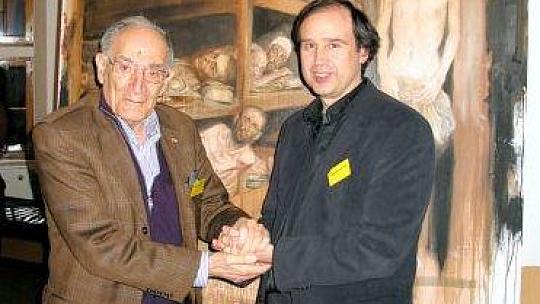 He is the son of a Dutch diamond polisher and baseball player, Hartog Hamburger. During a competition game in 1924, Hartog was hit on the head by a line drive when in the field. He died the next day as a result of the impact.
He is the son of a Dutch diamond polisher and baseball player, Hartog Hamburger. During a competition game in 1924, Hartog was hit on the head by a line drive when in the field. He died the next day as a result of the impact.
In February 2010, Max participated in the panel discussion of the Aachen Rabbi Mordechai drill in the German city of Aachen, along with the artist Máro and several others.
Both Máro (right) and his painting are shown in photo above, with Hamburger (left). According to the German news account:
“The discussion was all about the [then] 90-year-old Holocaust survivor Max Hamburger, whose speeches have gained great respect and […] the painting shown in the Castle Gallery by Máro, the image of a scene from the Buchenwald concentration camp.
“The artist explained the reasons which led him to the theme of the sufferings of Auschwitz. The series of pictures, which deals with the darkest chapter of German history, are meant to generate compassion and sensitivity for the suffering of the people depicted. […] Besides the issue of the Holocaust was also the art world itself, and the responsibility of the artist to contribute to the discussion of the Nazi terror, [which was] the focus of the [panel] discussion.”
Night #1 and Night #2—What Changes were Made and Why, Part Two
By Carolyn Yeager
copyright 2012 Carolyn Yeager
Elie Wiesel questioned under oath in a California courtroom in 2008:
Q. And is this book Night that you wrote a true account of your experience during World War II?
A. It is a true account. Every word in it is true.
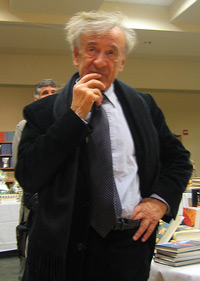
Elie Wiesel manning his table at a Jewish book fair in Austin, TX, 2006. The new translation of Night by his wife Marion had come out in January of that year, and it was immediately chosen for Oprah Winfrey’s book club.
In Part One, I established that the decision to rebrand Night into an autobiography was the reason for a new translation, in which necessary changes could be made to better ‘fit’ the story both to the real Elie Wiesel and the known facts of the Hungarian deportation.
When the 2006 translation came out, with its new classification to “autobiography,” questions arose from some circles. Responding to these questions, Edward Wyatt wrote an article in the NewYork Times on Jan. 19, 2006, in which he quoted Jeff Seroy, senior vice president at Farrar, Straus & Giroux, parent company of Night publisher Hill & Wang, as strongly denying that changes were made to bring the book more in line with the facts. “Nonsense,” said Seroy. “Some minor mistakes crept into the original translation that were expunged in the new translation. But the book stands as a record of fact.”
Blaming the Translator
“Mistakes in the original translation” can only mean mistakes by Stella Rodway, the original translator! But we have already shown that Stella Rodway faithfully reproduced the French La Nuit, which was Wiesel’s own work. The author and publisher are casting these changes as translation errors to divert attention away from Elie Wiesel’s own errors—part of their campaign to pass Night off from now on as “a record of fact.”
A record of fact it isn’t
When I ended Part One, Eliezer and Father were still in the train car on their way to Buchenwald. You will recall that the Yiddish, the French and thus the original English version of Night specified the trip took 10 days and 10 nights from Gleiwitz (on the former German/Polish border) to Buchenwald. Since we know from standard historical sources1 that the prisoners were evacuated from Monowitz on Jan. 18 and arrived in Gleiwitz the next day, Jan. 19; and since according to the description in Night itself, they spend three days in Gleiwitz (Jan. 20-22), this would make their day of arrival February 1, 1945. But in Night, Father’s death takes place the night of Jan. 28-29, three days before they arrived! This is why Marion Wiesel removed the number 10 in her new translation, leaving the number of days and nights undetermined.
A strange detail that actually belongs in Part One is on page 87 of the original Night. Eliezer remarks, after his and his Father’s deliberations and final decision to go on the march: “I learned after the war the fate of those who had stayed behind in the hospital. They were quite simply liberated by the Russians two days after the evacuation.” The evacuation, as we all know, was on the 18th. We also know the Russians did not arrive on the 20th of January! The actual liberation day is January 27. What possessed Wiesel to write this? Well, because it was in Un di velt: “Two days after we had left Buna, the Red Army occupied the camp. All the sick had stayed alive.”
From the point in the story of Eliezer and Father’s arrival at Buchenwald there are no significant changes made by Marion Wiesel to the original French and English versions. But there is much in all the versions that differs strikingly from the “official holocaust history” as written by acknowledged official chroniclers such as Danuta Czech. So I will continue with comparisons between Night and “official history,” along with some very significant changes made from Un di velt hot geshvign to Wiesel’s edited French La Nuit.
Arrival at Buchenwald: 26 Jan. or 1 Feb.?
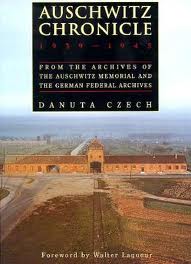 Danuta Czech, in her Auschwitz Chronicle1, records that on January 26,
Danuta Czech, in her Auschwitz Chronicle1, records that on January 26,
A transport with 3,987 prisoners from Auschwitz auxiliary camps reaches Buchenwald. There are 52 dead prisoners in the transport. 115 prisoners die on the day of arrival. Their corpses are delivered to the autopsy room. (P 801)
This is the transport that carried Lazar and Abraham Wiesel/Viezel, Miklos (Nikolaus) Grüner and all of the inmates of Monowitz whose names are on the transport list.2 According to Czech, the Monowitz prisoners began their march on the evening of January 18, 1945, with “divisions of nurses placed between the columns” of 1000 each (P 786), arriving at Gleiwitz Camp the following evening. On Jan. 21 “they are loaded in open freight cars with other prisoners from Auschwitz who have arrived in Gleiwitz.” (P 788) From Jan. 21 to Jan. 26 is five days of travel … not ten, as Wiesel wrote in Night.
The narrative in Night gives us a date of Jan. 22 for the boarding of the train, one day later than Czech. And while Night gives the number of days on the train (10), it does not name the date of arrival.
Hilda Wiesel says her father died on arrival
Totally contradicting what is written in Night, Hilda Wiesel Kudler, Elie’s oldest sister, in her testimony for the Shoah Foundation in 1995, said she learned from her brother that their father died as he stepped off the train.
And I said, where is father? And he replied, he’s gone back to Sighet; he[Elie] didn’t want to tell me [that he was dead]. And I repeated, but where is he? And he insisted he was at Sighet. And I said, look, I want you to tell me the truth. Because he knew the date of my father’s death. You know, they did a long march3 from Auschwitz, then they put them on the train to go to Buchenwald; he died gasping for air; when he stepped off the train, he died gasping for air; at Buchenwald. But he[Elie] knew the date.
From this, we can better understand something about Elie Wiesel—that he has never had a problem with making up stories that “sound better” than the truth. But, if Hilda is correct in her recall, and if their father really was one of the 115 inmates who Danuta Czech reports died on the day of arrival, then Wiesel’s long, melodramatic story of watching his father sicken and die over a ten-day period in Night is fiction. All of it—including his father being whacked on the head by a cruel “officer” in the barracks.
The day of arrival for this transport is Jan. 26, but according to the timeline in Night, it arrives on Feb. 1. Either way, it doesn’t correspond to the date of Jan. 28 that Wiesel, for reasons unknown, selected as the date his fictional Father died.
You might also be interested to know that Hilda is named Deborah in Un di velt; the name Hilda is never used. It was Wiesel who changed it to Hilda in La Nuit.
Un di Velt says Father dies a week after arrival in Buchenwald, Night says 8-10 days … yet it is January 28 … or is it the 18th Day of Shevat?
Regular readers of this blog will know this already, but it bears repeating yet again: there is no Shlomo Wiesel in the official history or in the records who fits the profile of “Father” as described by Elie Wiesel in Night. There is an Abraham (sometimes shortened to Abram) Viezel who is recorded in several places—on a medical report at Auschwitz, on the transport to Buchenwald, and on a death certificate dated Feb. 2, 1945, seven (7) days after arrival. This Abraham was born Oct. 10, 1900, making him 44 years old when he died. Recall that Night gives Father’s age as 50 in 1944 (SR, P 40).
Wiesel’s description has the transport to Buchenwald arriving on Feb.1st. But that’s just the beginning. After arriving, this is the timeline given in both the original Night and Marion Wiesel’s 2006 translation:
It was daytime when I awoke. I went to look for my father. (Feb. 2nd)
[…]
On the third day after our arrival at Buchenwald, everyone had to go to the showers [his father went too-cy]. Even the sick who had to go through last. (Feb 4th) […] Struck down by dysentery, my father lay in his bunk, five other invalids with him. I sat by his side watching him … A week went by like this. (Feb. 11th or Feb. 8th depending on how you read it)
[ . . . ]
When I got down after roll call, I could see his lips trembling as he murmured something. […] Then I had to go to bed. I climbed into my bunk, above my father, who was still alive. It was January 28, 1945. (still Feb. 8 or 11) I awoke on January 29 at dawn. In my father’s place lay another invalid. They must have taken him away before dawn and carried him to the crematory.” (Feb 12th or 9th) [Stella Rodway translation, pp 107-112]
The timeline in Un di velt is not in doubt:
On the seventh or eighth day of our being in Buchenwald, the bunk-elder [should be block-elder -cy) who used to deal out bread for the whole bunk [sic], came to me. . . .
[ . . . ]
On the same day, in the evening, disaster struck. The end. During roll call. The healthy had to go out of the block in order to be counted by the S.S. men. The sick stayed in their bunks. My father and I thus stayed inside. He — because of his dysentery and I — because of my bandaged foot. Father was lying in the lowest bunk and I — in the uppermost.
[ . . . ]
After roll call, I immediately jumped down from the uppermost bunk and ran to him. He was still breathing. But — he was silent.
[ . . . ]
For a couple of hours I stayed by him and looked at his face long and well […] Then they forced me to go lie down to sleep. I climbed up to the uppermost bunk and I did not know that in the morning, on awakening, I would find my father no more.
It was the eighteenth of Shevat, 5705.
* * *
Nineteenth of Shevat. Early in the morning.
I got up and ran to my father. Another sick man was lying in his place.
I had a father no more. (pp 233-238)
Readers might be surprised to learn that the Hebrew calendar date of 18-19 Shevat, 5705 corresponds to February 1-2, 1945! How neat is that? So, in Un di velt Father dies seven days after arrival, on the very same day as Abraham Viezel died, who was officially recorded at Buchenwald with the registration number of 123488 and the Auschwitz registration number of A-7712. (However, Un di velt also says that the trip from Gleiwitz to Buchenwald took ten days, which means they could not have arrived until sometime in February. Seven days from that time would not be Feb. 2nd.)
So can we conclude from this that Abraham is Shlomo? Not necessarily. The Yiddish author reports Father’s death as occurring during the night of 18-19 Shevat (Feb. 1-2), but Elie Wiesel, author of La Nuit, says the date is Jan. 28th! Why? Who can answer that but Elie Wiesel? He certainly knows what the month of Shevat and the year 5705 means … or he could have easily found out.
Or can we conclude that Un di velt was written by Lazar Wiesel, as Nikolaus Grüner claims … that he wrote his story as a father-son relationship … and that he was perhaps not the brother of Abraham as Grüner says he was? (It’s noted on Lazar’s Buchenwald file card that his father was also in Buchenwald; his mother in Auschwitz.) Well, again, not necessarily. There are other possibilities. But I’m getting ahead of myself.
The facts are, there are problems with all of these theories; none is a perfect fit. We can ask: If Elie Wiesel is the author of Un di velt hot geshvign, why did he change so many of the underpinning facts of the story when he rewrote it in French as La Nuit? This is a real head-scratcher. We can also ask: Why did Naomi Seidman, the Jewish professor who discussed in detail some of the differences between the Yiddish book and Night, not mention the 18th of Shevat? Is it because she couldn’t find an explanation for it? Siedman, Ruth Franklin and other Jewish reviewers have never brought up some of these Yiddish to French discrepancies. They are too embarrassing a problem for them.
What we can safely say is that no matter who the author of Un di velt was … he was totally unfamiliar with the real facts of when the Monowitz prisoners arrived at Buchenwald. Was it because he was not one of them? Was it because he was not concerned about accuracy since his story was directed at a non-critical audience—a Yiddish-speaking Jewish audience? As we continue, we’ll find more mystifications, but also a few certainties.
What happens to Eliezer after Father’s death?
Wiesel writes in Night (essentially the same in all translations):
I had to stay at Buchenwald until April eleventh. I have nothing to say of my life during this period. […] I was transferred to the children’s block, where there were six hundred of us. […] I spent my days in a state of total idleness. And I had one desire—to eat. I no longer thought of my father or of my mother. (SR, P 114)
He continues that on April 10, a general evacuation of the remainder of the camp—20,000 prisoners in all, including “several hundred children”—was begun but was soon interrupted. It resumed on the 11th but was again interrupted around ten a.m. when the camp inmate “resistance movement” rose up, firing guns. And then at 6 p.m. on that same day the first American tank arrived. This corresponds pretty well with the official story, but then it goes astray.
In a November 2000 interview with Oprah Winfrey, Wiesel recalled:
… and we [children] were left until the end. But every day we marched to the gate anyway. I was near the gate more than five times before I was released, and each time, the gate closed just before I came to it.
Ah, we have heard this before, haven’t we? As exaggerated as it sounds, in Un di velt the author goes even further. He writes:
I didn’t even bother to try hiding myself. Let myself be born along with the stream. Tens of times I stood before the iron camp gate, on the threshold of death, and always something happened which brought us back to the block.
Un di velt continues: “If I was not killed then it is merely thanks to almightly chance. For – because of the hunger, I even wanted to go to the gate: outside the gate, they were distributing bread and marmalade.”
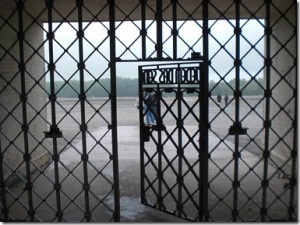
The front gate at Buchenwald, from the inside looking out, that Wiesel says he marched right up to “tens of times” but was always turned back!
- Liberation brings Freedom and Revenge
UdV, P 244: The first gesture of freedom: the starved men made an effort to get something to eat. They only thought about food. Not about revenge. Not about their parents. Only about bread. And even when they had satisfied their hunger—they still did not think about revenge.
SR, P 115: Our first act as free men was to throw ourselves onto the provisions. We thought only of that. Not of revenge, not of our families. Nothing but bread.
Oprah Winfrey interview: Oprah asks, “After you were liberated, what did you do?” Wiesel answers: “The first thing many of us did was reassemble to say a prayer for the dead.” (page 5)
* * * *
UdV, P 244: Early the next day Jewish boys ran off to Weimar to steal clothing and potatoes. And to rape German girls [un tsu fargvaldikn daytshe shikses]. The historical commandment of revenge was not fulfilled.
LN, P 178: Le lendemain, quelques jeunes gens coururent à Weimar ramasser des pommes de terre et des habits—et coucher avec des filles. Mais de vengeance, pas trace.
SR, P 116: On the following day, some of the young men went to Weimar to get some potatoes and clothes—and to sleep with girls. But of revenge, not a sign.
MW, P115: The next day a few of the young men ran into Weimar to bring back some potatoes and clothes—and to sleep with girls. But still no trace of revenge.
In this case, Wiesel made the change from ‘rape’ to ‘sleep with’ in La Nuit. The expression for “German girls” that we find in the Yiddish book was also removed. The term that was actually used is shikses, a word which originally meant “abomination” and which is used today as a term of contempt for all non-Jewish women. In other words, in saying daytshe shikses, the author was expressing, in rather vulgar terms, his contempt and hatred for German women. This apparently was not good for the eyes of the Goyim to see. It was changed by Wiesel in the French La Nuit, and thus it never reached our eyes until now.
Yet, the Yiddish author goes even further and decries the failure of the Jewish males to take a proper revenge, which is here envisioned as a much larger public act of retribution than the “too mild” raping of German women. (Public retribution, of course, did come later with the Nuremberg Military Tribunals.)
Eliezer is hospitalized for two weeks—April 14 to April 28
UdV P 244: Three days after liberation I became very ill; food-poisoning. They took me to the hospital and the doctors said that I was gone. For two weeks I lay in the hospital between life and death. My situation grew worse from day to day.
SR P 116: Three days after the liberation I became very ill with food poisoning. I was transferred to the hospital and spent two weeks between life and death.
MW P 115: Three days after the liberation of Buchenwald, I became very ill: some form of poisoning. I was transferred to a hospital and spent two weeks between life and death.
Three days after liberation on April 11th is April 14th. Thus, Eliezer is in the hospital from April 14 until April 28—extremely ill, close to death. In his 1995 memoir, All Rivers Run to the Sea, Elie Wiesel claims that on that day (the 14th) he was thrown a can of lard, which he apparently ate although he doesn’t remember doing so. He lost consciousness and awoke in a hospital. But the addition of this story, which is in the original Un di velt, presents serious problems for Elie Wiesel. Perhaps the hospital story had slipped his mind when he decided to claim he was one of the survivors lying on a bunk in the “famous Buchenwald liberation photograph.” Because he was in the hospital …
He cannot be in the famous Buchenwald liberation photo taken on April 16 …
I have already demolished the false claim that Wiesel is in that photograph here. But on top of that, our translator found an interview of Leo Eitinger, a Jewish Czech-born psychiatrist, by Harry James Cargas, a friend and biographer of Elie Wiesel, which contained this gem:
HJC: The same thing happened with Livia Rothkirchen at Yad Vashem as happened with you. I was there doing research on atrocity photography for my book A Christian Response to the Holocaust and saw a photo that covers a large wall, of seventeen men lying in their bunks at liberation time. I think you’ve probably seen this picture. Wiesel and Dr. Rothkirchen passed it by many times, over a several-year period, before he told her he was in that photograph. I asked Elie if I could write something about it and he said, “No.” I wrote something and showed it to him and he gave me permission to publish it.
The photo at Yad Vashem in Israel with Elie Wiesel posing in front of it in 1986 after receiving the Nobel Peace Prize in Oslo.
LE: I didn’t know Elie is in the photo.4
Cargas’ book was published in 1993, ten years after it was publicly announced that Elie Wiesel was in that photograph. Apart from the revelation that Cargas has to ask permission from Wiesel before he publishes anything about him, can you imagine that after walking by that famous photo for several years, Wiesel would finally think to say, “Oh hey, that’s me laying there, back in the shadows.”
He cannot have been present to agree to and sign the Military Questionaire on April 22 …
Much has been made by holocaust historians like Kenneth Waltzer and others I won’t name that this Fragebogen made out for Lázár Wiesel proves that Elie Wiesel was in Buchenwald. The birth date is not Elie’s; the date of arrest is not Elie’s; the signature is not Elie’s; the registration number belongs to another prisoner (Pavel Kun) who died only a month earlier; and on top of all that … Elie himself tells us in Night that he was lingering between life and death in the hospital on April 22. He was still six days away from having recovered enough to leave the hospital.
He cannot be in the photograph of the “Boys of Buchenwald” taken on April 27.
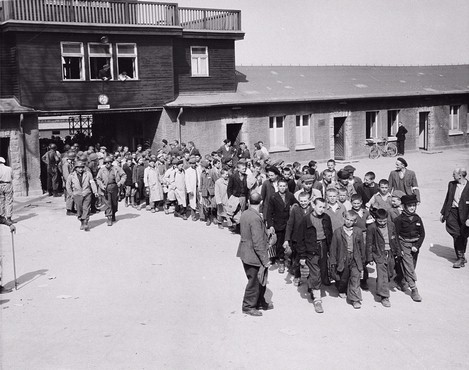 Kenneth Waltzer also claims on his Michigan State University website that Elie Wiesel is “seen to the left” (short boy fourth from the front in left row wearing dark suit in front of the taller boy wearing a beret) in this photograph of the youths being transferred from the barracks inside Buchenwald to the former SS barracks on the outside. Why is Waltzer not paying attention to what is written in Night — that Eliezer was put in the hospital on the 14th of April, at death’s door, and remained for two weeks? One really has to wonder at the stupidity of holocaust historians. Or more likely — how stupid they think the rest of us are! See The Many Faces of Elie Wiesel.
Kenneth Waltzer also claims on his Michigan State University website that Elie Wiesel is “seen to the left” (short boy fourth from the front in left row wearing dark suit in front of the taller boy wearing a beret) in this photograph of the youths being transferred from the barracks inside Buchenwald to the former SS barracks on the outside. Why is Waltzer not paying attention to what is written in Night — that Eliezer was put in the hospital on the 14th of April, at death’s door, and remained for two weeks? One really has to wonder at the stupidity of holocaust historians. Or more likely — how stupid they think the rest of us are! See The Many Faces of Elie Wiesel.
The book’s ending: What does the long passage in Un di velt hot geshvign tell us?
UdV P 245: One fine day I got up—with the last of my energy—and went over to the mirror that was hanging on the wall. I wanted to see myself. I had not seen myself since the ghetto.
From the mirror a skeleton gazed out.
Skin and bones.
I saw the image of myself after my death. It was at that instant that the will to live was awakened.
Without knowing why, I raised a balled-up fist and smashed the mirror, breaking the image that lived within it.
And then—I fainted.
From that moment on my health began to improve.
I stayed in bed for a few more days, in the course of which I wrote the outline of the book you are holding in your hand, dear reader.
But—
Now, ten years after Buchenwald, I see that the world is forgetting. Germany is a sovereign state, the German army has been reborn. The bestial sadist of Buchenwald, Ilsa Koch, is happily raising her children. War criminals stroll in the streets of Hamburg and Munich. The past has been erased. Forgotten.
Germans and antisemites persuade the world that the story of the six million Jewish martyrs is a fantasy, and the naive world will probably believe them, if not today, then tomorrow or the next day.
So I thought it would be a good idea to publish a book based on the notes I wrote in Buchenwald.
I am not so naive to believe that this book will change history or shake people’s beliefs. Books no longer have the power they once had. Those who were silent yesterday will also be silent tomorrow. I often ask myself, now, ten years after Buchenwald:
Was it worth breaking that mirror? Was it worth it?
SR P 116: One day I was able to get up, after gathering all my strength. I wanted to see myself in the mirror hanging on the opposite wall. I had not seen myself since the ghetto.
From the depths of the mirror, a corpse gazed back at me.
The look in his eyes, as they stared into mine, has never left me.
MW P 115: One day when I was able to get up, I decided to look at myself in the mirror on the opposite wall. I had not seen myself since the ghetto.
From the depths of the mirror, a corpse was contemplating me.
The look in his eyes as he as he gazed at me has never left me.
The difference in length between the Yiddish and the English passage is the first thing that strikes us. The Yiddish writer had a lot to say in these final thoughts. He regained his “will to live” right there in the hospital. Twice he speaks of writing an outline and notes for Un di velt hot geshvign while still in his hospital bed. But there is no record by Elie Wiesel anywhere that says he did any writing in preparation for writing his “testimony” while in the camp (in fact, just the opposite), or at any time in advance of 1954.
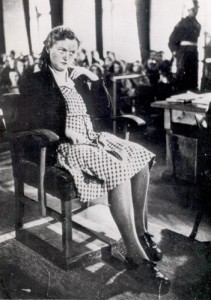
Ilse Koch on the witness stand in 1947. She was seven months pregnant and the only woman brought before the American Military Tribunals held at Dachau.
The tragic true story of Ilse Koch is that she gave birth to one child while a prisoner of the Americans but she certainly was not allowed to raise him. She was hounded, vilified and persecuted after the war, retried by a German court in 1951 after being acquitted at the IMT, and ultimately given a life sentence—solely, it can be argued, to satisfy Jewish vengeance. She committed suicide in prison in 1967.
The Yiddish author also mentions the “six million Jewish martyrs” … in 1954. This number emerged from the Nuremberg Tribunals, but we know that claims of “six million Jewish victims” goes all the way back to the 1890’s.
All this and more was cut out for the French La Nuit (which, remember, was written by Wiesel) and the English versions which were taken from the French. As has been noted by Jewish commentators themselves, the Yiddish writer is an angry, politically-minded religious Jew who expected, or wished, the world to have been transformed by the travail of the Jews during WWII. He is bitterly disappointed. There is more in this final chapter of the Yiddish book that doesn’t appear in the French or English versions. Here is just one passage:
Dreams of truth, of freedom are false dreams for men. Visions of justice and equality are false visions for men. Man is: the struggle for bread, for meat; man is: the struggle to satisfy one’s own instincts.
Man is instinct to the core. Flesh to the core. And not heart. And not spirit. And not morality.
I learned that in Buchenwald. And what one learns in such conditions is without a doubt the truth, the purest truth. For man can really know man only in extreme conditions, when he has thrown away from himself all masks, social and psychological, and appears before us naked, as he is in truth.
In Buchenwald I saw the true face of man. The face of a human animal, which is worse than a true animal. O God, woe is you, woe is man, how trifling and puny. Ought you to even exist, if the son of Adam was made in your image!
God . . . I had ceased to believe in his existence. But despite that, I continued to believe in his evil. (UdV, P 240-41)
Was this written by Elie Wiesel? If it was, he is a man who has put on his own mask to play the game of Jewish vengeance against the goyim persecutors of his people. In other parts of Night, Wiesel writes of losing his faith in a caring God, of no longer following his religion—but later he denied that is true, even though he wrote it! But this passage in Un di velt is too passionate to dismiss as merely a passing sense of discouragement. That is, of course, unless it is just a literary construct and doesn’t reflect any truth of the author.
What does it all mean?
The title of this two-part article is “What Changes were made to Elie Wiesel’s Night, and Why.” I didn’t promise to solve the mystery of the author of Un di velt hot geshvign, but I did hope I might do so, or at least eliminate some contenders.
I confess I expected there to be more difference between the Yiddish and the French books than it turns out to be. It is now clear that La Nuit was taken directly from Un di velt, although that doesn’t mean they were written by the same person. However, that is the greater likelihood unless it can be proven otherwise. Similarly, if Elie Wiesel is the author of Un di velt, it doesn’t mean he was in the camps. The fact that the books are filled with errors argues against it.
Night is a novel
It’s difficult to come to any certainties when the material we have to work with is so internally inconsistent and when there are several versions of it—similar in some ways to the many versions of the Anne Frank Diary. But we can conclude for certain that Night only works as a novel, not as an autobiography—no matter how much the Jewish spin doctors say that a memoir, to be a work of “great literature,” must include some fictional flights of fancy. Nowhere does Night fit the facts. Even with wife Marion’s changes in 2006, it couldn’t be pulled together enough to make a convincing true-life testimony. And we know how many of these “survivor novels” there are around. It’s not like many other hopefuls didn’t have the same idea!
The Lazar-Lázár Riddle
In spite of all the above, I would like to propose a hypothetical scenario, one that I am not endorsing, for obvious reasons, but that does have the value of answering one of the more ignored aspects of this riddle, namely the way the 32-year-old Lazar Wiesel disappeared at the same time the 16-year-old Lázár Wiesel appeared. This cannot be denied. Thirty-one-year-old Lazar arrived at Buchenwald in January; sixteen-year-old Lázár left there in July. The easiest explanation for this is that Lazar wanted to have the papers of a 16-year-old Buchenwald orphan so he could be sent to France. In the confusion of the last months of the war and the immediate post-war period, this kind of thing became more possible. Such an explanation may sound a little far-fetched, but is it any harder to swallow than Elie Wiesel not having the tattoo (Auschwitz ID number) that he says he has? Or Elie Wiesel not having his own Buchenwald identification number, but “borrowing” a dead man’s (Pavel Kun, 2 years older than Elie) right before, or after, liberation? These things don’t make sense. Nor does the fact that in La Nuit Elie Wiesel wrote that his father died on Jan. 28, 1945, while in the Yiddish book that he also claims to have written as his own “testimony” the date is Feb. 2nd? Or that he wrote that the Russian Army took over the Auschwitz complex two days after its evacuation, which everyone knows is false?
Elie Wiesel even wrote in Night that his foot was operated on right before the evacuation of Auschwitz, while in his later real memoir, All Rivers Run to the Sea (pp 89-90), he flat-out recalled it as his knee, something that could not be mis-remembered. I could list many of these senseless “mistakes,” many of which I have written about in earlier articles.
There is something that doesn’t fit well into this Lazar-Lázár hypothesis, though—that is, that we have pictures of the real Elie Wiesel in France at the Jewish welfare orphanage, OSE. But how did he get through a year at Auschwitz and Buchenwald with no records of his being there … and a poor memory of what occurred and when? Did he somehow manage to attach himself to the Buchenwald transport with the stolen identity papers? But also, there are other ways he could have come to be at the Ecouis homes in France than in the children’s transport from Buchenwald. Just as there are other ways he could have come into possession of the Yiddish Un di velt without writing it himself.
Was Elie Wiesel in the camps?
My answer is still no. Wiesel could have been in some camps in some capacity under some auspices, but he is not telling the truth about what camp experience he did have. That means Hilda Wiesel Kudler is also not telling the truth but is standing by her brother. She says at the end of her bitter testimony to the Shoah Foundation, “I will not forget, and I will not forgive.” Have you ever wondered why Elie has not contributed a videotaped testimony to the Spielberg/USC Shoah Foundation library?
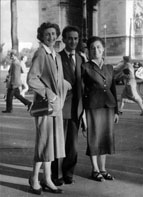
Elie Wiesel with his older sisters Bea (left) and Hilda (right) in Paris after the war, exact date unknown.
Wiesel’s other sister, who changed her name to Beatrice from Batia, never wrote or testified a word about it. She did go to work for Jewish organizations in Germany, however, immediately after the war, helping Jews to emigrate to wherever they wanted to go, including Palestine. The whole family were committed Zionists, as were most Eastern European/Russian Jews who were able to flood into the West because of the war. ‘Bea’ finally got her own papers to emigrate to Canada.
A Jewish organization, Sharit Ha-Platah, gathered names of Jews who were liberated from Dachau and it’s many sub-camps and published them in 1946. This is the only record so far found with the names of Hilda and Beatrice Wiesel, and it is a self-identified list of Jews by Jews, not an official German record of forced laborers or prisoners. So the hard evidence for the Wiesel family is not there. It doesn’t mean they weren’t, however; it’s just that we’re left with believing what they say, because we want to or because we’re expected to.
The easiest option is to go along with Elie Wiesel’s story that he was in those camps, and question his credibility from other angles, such as the in-credible stories he tells. This is what revisionists had done before Nikolaus Grüner came along and released documents he had obtained from Buchenwald and the correspondence he had with the archivists there. These documents cannot be ignored, in spite of what other nonsense Grüner writes in his book Stolen Identity. These documents have caused a sea change in revisionism about Elie Wiesel, to the extent that it can be divided between pre-Grüner and post-Grüner research and writing.
Wiesel needs to expose himself to questions
Because of these documents, it is up to Elie Wiesel to come forth and answer questions about them. But being that he is completely unprepared to do so, this job has been given to his surrogates—Professor Waltzer for one. Kenneth Waltzer promised, with a lot of bombast, that he would produce proof that Elie is Lazar and that Shlomo is Abraham, but for a year now he has failed to produce it, or even say anything more about it. He has also failed to come out with his promised book, “The Rescue of Children and Youths at Buchenwald,” which was to include Elie Wiesel. In the opinion of this writer, Waltzer is as big a fraud as Wiesel, selling emotion and sentimentality instead of factual history. They are both supported with professorships at well-funded universities.
So, back to the main question: Was Elie Wiesel in Auschwitz and Buchenwald? As I said, my answer is still no … and no one should accept that he was without some further explanation from him, during which he subjects himself to questions. If he’s genuine, he can certainly withstand questions. That, however, is not going to happen because … fill in your own answer.
Elie Wiesel has kept the details of his life before 1955 vague. He has managed to prevent unwanted questions from being asked of him. He hides behind a stated aversion to “holocaust deniers” so that anyone who is not a 100% believer is not welcome in his company. He gets away with the ‘moral outrage’ he professes toward anyone who doubts, thus no interviewer, reporter, writer, academic, student or even President dares to doubt in his presence. It works like a charm.
Endnotes
1. Danuta Czech, Auschwitz Chronicle: 1939-1945. New York: Henry Holt, 1997
2. APMO, D-Bu 3/17, pp. 18-85, 87 (transport list as cited by Czech in Auschwitz Chronicle)
3. Hilda was obviously unaware that the march itself was only 24 hours, probably because she had heard so many false and exaggerated stories about “endless days of marching” that proliferate in survivor stories.
4. Harry James Cargas, ed. Voices from the Holocaust, Lexington: University of Kentucky Press, 1993. pp. 116-22.
Buchenwald Memorial Archivist Cannot ID Elie Wiesel as an Inmate
by Carolyn Yeager
copyright 2011 carolyn yeager
Accepts Yad Vashem propaganda book as good enough to go by.
According to a letter (see below) received by a German reader of this website from Sabine Stein of the Gedenkstatte Buchenwald (Wiemar, Germany), the Buchenwald Memorial’s acceptance that Elie Wiesel is one of the men in the famous Buchenwald Liberation photograph is based on the reliability of Yizhak Arad’s The Pictorial History of the Holocaust. This book was published several years after the New York Times announced to the world that Elie Wiesel was in the picture, and the U.S. Holocaust Museum went along with it. There has never been any real, or convincing, verification that the man in the picture is Elie Wiesel.
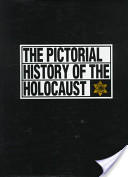 Originally published in 1990, The Pictorial History of the Holocaust was edited by Yizhak Arad; designed by Hava Mordohovich, published by the Yad Vashem Holocaust Martyrs’ and Heroes’ Remembrance Authority in Jerusalem. It says on the copyright page: The publication of this album was made possible through the initiative and generosity of Miriam and Haim Schaechter. The Editorial Board is composed of Yizhak Arad, Reuven Dafni, Gideon Greif and Yehudit Levin. Maps drawn by Alissa Gold. The book is a 100% Jewish-Israeli production (note the Star of David on the cover) and is partisan propaganda.
Originally published in 1990, The Pictorial History of the Holocaust was edited by Yizhak Arad; designed by Hava Mordohovich, published by the Yad Vashem Holocaust Martyrs’ and Heroes’ Remembrance Authority in Jerusalem. It says on the copyright page: The publication of this album was made possible through the initiative and generosity of Miriam and Haim Schaechter. The Editorial Board is composed of Yizhak Arad, Reuven Dafni, Gideon Greif and Yehudit Levin. Maps drawn by Alissa Gold. The book is a 100% Jewish-Israeli production (note the Star of David on the cover) and is partisan propaganda.
But the Buchenwald Memorial outside of Weimar has nothing better to point to as why we should believe that Elie Wiesel was one of their famous “guests.” This book captions the picture in question as: “Elie Wiesel, Nobel Peace Prize winner 1986, is the farthest right on the second tier from below.” Interesting that they add Nobel Peace Prize winner, isn’t it? That was the whole purpose of claiming Elie to be in the picture to begin with.
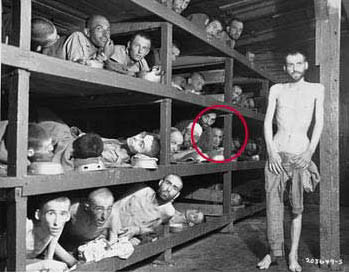 Sabine also admits that Simon Toncman (standing, who never identified himself in the picture) was identified by his internee number, while all others who are supposedly known to be in the picture recognized, i.e. identified, themselves. That means Elie Wiesel is self-identified, as is Myklos Grüner.
Sabine also admits that Simon Toncman (standing, who never identified himself in the picture) was identified by his internee number, while all others who are supposedly known to be in the picture recognized, i.e. identified, themselves. That means Elie Wiesel is self-identified, as is Myklos Grüner.
To put a better face on this, Ms. Stein tells the letter-writer about the questionnaire of 22 April 1945. But as we know, this questionnaire was filled out for Lázár Wiesel with a birthdate of Oct. 4, 1928, not Sept. 30 which is Elie’s birthdate, and the hand-written signature on the questionnaire doesn’t match Elie’s later known signature. The Buchenwald ID number given to this Lázár Wiesel is 123165, which had formerly belonged to a Pavel Kun who died on 8th March ’45 (one month earlier!) That means it could not have been given to Elie Wiesel when he arrived and was registered at the end of January ’45. Why would young Elie Wiesel be given, in April, a new ID number that had belonged to a recently deceased inmate? And at the same time be given a new birthdate? With all these problems, this questionnaire is still used, along with the photograph, to “prove” Wiesel was detained in Buchenwald. I conclude that the Memorial Museum is only going along with these weak pieces of “evidence” because it is itself part of the “holocaust” business. We must remember that the Buchenwald Memorial was the creation of ex-inmates, mostly communists, who had. and still have, a vested interest in promoting the worst possible view of the National Socialist Germans. No exaggeration or lie was too great for them to enshrine as truth. The organization these ex-inmates formed still runs the Buchenwald Memorial site today.
All deceased internees names not known
Ms. Stein further tells our reader that her department cannot determine the names of all deceased internees of the KZ Buchenwald because at the beginning of 1945 arrivals died before their personal datas could be registered. However, the day and location of death was registered as “unknown deaths.” (We know that Shlomo Wiesel could not be one of these “unknown deaths” because his death, according to son Elie’s books, took place over a week after arrival. In addition, others in the transport Elie and Shlomo are said to have been on were registered.) According to Stein, there were a total 1265 of these deaths between Jan. 1 and April 11, 1945 and just who they are will be determined at a future time when the Bad Arolson archives are made available to them. (Can it be that the Arolson archives are open to Ken Waltzer of Michigan State University Jewish Studies Dept. but not to the Archive Dept. of the Buchenwald Memorial Museum? Strange stuff.)
Therefore, Sabine Stein says a complete list of the names of the liberated internees of the KZ Buchenwald, who were present at Buchenwald on April 16, 1945, is not available from her. In other words, she cannot clear up the mystery of Elie Wiesel, she can just go along with the narrative as it is and not make waves.
******
The letter from Sabine Stein to our reader, with personal information removed, is translated below into English.
07 09 11
Dear Mr. ______,
Please find the enclosed answer of your questions as per our previous notice.
Permit me some remarks concerning the general position of the memorial regarding its archive and documents.
The Archive of the memorial does not posses the original registration of the KZ Buchenwald, nor the original documents of the closing of the camp after its liberation in April 1945. Those documents are stored at the International Search Service of the Red Cross at Bad Arolsen (www.its-arolsen.org). The basis of our research is a biographical collection of individual persons and comprehensive reports for our archive. We started in 1971; for historical reasons it is therefore forced to be incomplete. In order to arrive at dependable results, additional relevant collections and archives have to be gained, specifically in regard to internees who were transferred to different national socialist concentration or destruction camps.
1) Photo 020-46007
With exception of Simon Toncman who was identified by his internees number, all other named persons recognized themselves. Elie Wiesel’s identification was based on the publication of Yizhak Arad’s The Pictorial History of the Holocaust, Maxwell Macmillan International 1992. On page 403 is the photo and on page 404 the following text appears: Buchenwald, after the liberation, survivors in their barracks. Elie Wiesel, Nobel Peace Prize winner 1986, is the farthest right on the second tier from below.
2) Regarding the liberated person Elie Wiesel, there exists a questionnaire on microfilm for inmates of the concentration camp 22nd of April 1945, (BwA 51-11-842). The original is at the aforementioned ITS (International Tracing Service) Arolsen.
When counting the dead internees based on the camp statistics, you made an error. According to documents of the camp office, official death is registered for the time span 1.1.1945 to 31.3 1945. (Jan. 1 to March 31—3 months -cy) During that time 13.910 internees died.
From 1.4.1945 until 11.4.1945, 913 internees died. (April 1 to April 11—10 or 11 days) This amounts (from 1.1 to 11.4 1945), to a total of 13,966 and not 13,969. (These figures don’t add up, but I double-checked them and this is what the original letter in German said.)
Throughout years of research we tried our best to determine the names of all deceased internees of the KZ Buchenwald. Yet at the beginning of 1945 arrivals died before their personal datas could be registered, in that case the statistics of the camp register them as “unknown” death. All those not-named deaths are registered at the data bank as “unknown death,” by day of death and location of death. For the time of January till April 1945 a total of 1265. Because the archive of the international search institute at Bad Arolsen unfortunately remained closed for us, the files available there are not yet worked into our memorial book. This will be done in the near future. A complete list with the names of the liberated internees of the KZ Buchenwald or the persons present at Buchenwald on 16.4.1945 is unfortunately not available. Further information might be found at the National Archive at Washington.
Of the 5 Buchenwald internees numbers, I can only name the one of Miklos Gruener (Michael Nikolas Gruener), 120762. The one of Wiesel, 123165, you know already. The other numbers I could not find because the number card is not handed down (or complete). Only ITS Arolsen can also help here.
Friendly Greetings
Sabine Stein/Archive

